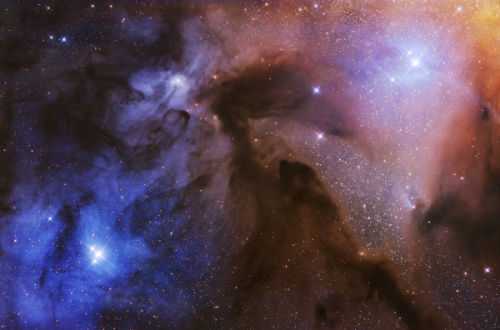Tag archives: Saturn
Prize-winning astronomy image, the ultimate cost of Cassini, amazing facts about lasers

Prize winning: the Rho Ophiuchi Cloud Complex captured by Artem Mironov (Courtesy: Artem Mironov)
By Hamish Johnston and Michael Banks
Hats off to the Russian photographer Artem Mironov, who has beaten thousands of amateur and professional photographers from around the world to win the 2017 Insight Astronomy Photographer of the Year. The award is in its ninth year and is run by the Royal Observatory Greenwich together with Insight Investment and BBC Sky at Night magazine. Mironox’s image, which was taken over three nights from a farm in Namibia, is of the swirling dust and gas clouds in the Rho Ophiuchi Cloud Complex. The object is situated approximately 400 light years away from Earth and is home to a cluster of more than 300 protostars. As well as winning the £10,000 top prize, Mironov’s image will be on display along with other selected pictures at an exhibition at the Royal Observatory that will run until 28 June 2018. The competition received over 3800 entries from over 90 countries. (more…)
View all posts by this author | View this author's profile
The sounds of Saturn, dancing particles, distracted funding agency
By Hamish Johnston
Astronomy can be a highly visual science and therefore developing ways of sharing data with visually impaired colleagues – and the public – is an important challenge. Sound offers one way forward, as astrophysicist Wanda Diaz Merced explains in “The sounds of science”. Now, fellow astrophysicists Matt Russo and Dan Tamayo at the University of Toronto have converted the motions of the rings and moons of Saturn into two musical compositions. You can listen to a composition based on the orbital frequencies of moons and rings by playing the video above. The second piece is called “Resonances of Janus translated into music”.
View all posts by this author | View this author's profile
Cassini’s emotional countdown, Steve the light show, shooting hoops ‘granny style’
By Sarah Tesh
This week has seen the beginning of Cassini’s Grand Finale. The rather dramatically named final mission for the NASA spacecraft involves 22 dives between Saturn and its surrounding rings. Once complete, Cassini will crash into the planet’s atmosphere in what the scientists hope will be a flurry of data gathering. The spacecraft has already sent back stunning images of storms in Saturn’s atmosphere from its first dive on 26 April. After 20 years since its launch, the mission to Saturn’s system has been a masterclass in space exploration, and NASA highlights the best bits in this theatrical video. The short film, reminiscent of Star Trek, could be considered a bit cheesy, but it’s hard not to form an emotional attachment to NASA’s loyal Cassini as you join in the countdown to its final demise.
View all posts by this author | View this author's profile
NASA asked, so we waved at Saturn
By James Dacey

Wave at Saturn collage. (Courtesy: NASA/JPL-Caltech)
On 19 July the Cassini spacecraft turned back to face Earth from its location by Saturn and captured this humbling photo of our planet as a tiny dot behind Saturn’s rings. As part of the event, NASA encouraged people to snap pictures of themselves waving at Venus and to share these via social-media sites. Now, 1400 of these images have been used to create this collage, which includes people from more than 40 countries and 30 US states.
“While Earth is too small in the images Cassini obtained to distinguish any individual human beings, the mission has put together this collage so that we can celebrate all your waving hands, uplifted paws, smiling faces and artwork,” says Linda Spilker, Cassini project scientist at NASA’s Jet Propulsion Laboratory in California.
NASA has, however, released a larger version of the “Wave at Saturn” collage where you can zoom in to make out individual images. It is well worth doing so, as you quickly come across the whole spectrum of gestures from the gentle wave to the Vulcan salute.
View all posts by this author | View this author's profile
Icy spray from Saturn’s moon Enceladus sampled by Cassini

Cassini’s enhanced and false-coloured image of Enceladus backlit by the Sun shows the fountain-like plumes of the fine spray of material that spews from the south polar region (Courtesy: NASA/JPL/Space Science Institute)
By Tushna Commissariat
Enceladus, Saturn’s sixth largest moon is back in the news as the Cassini-Huygens mission has managed to directly sample the water plumes jetting into space from its southern polar region. These plumes of ice and salt originate from the moon’s famed “tiger stripes” region – four parallel giant fissures on the southern face of the moon.
The findings from these fly-throughs are the strongest evidence yet for the existence of large-scale saltwater reservoirs beneath the moon’s icy crust. “Enceladus is a tiny icy moon located in a region of the outer solar system where no liquid water was expected to exist, because of its large distance from the Sun,” says Nicolas Altobelli, ESA’s project scientist for the Cassini-Huygens mission. “This finding is therefore a crucial new piece of evidence showing that environmental conditions favourable to the emergence of life may be sustainable on icy bodies orbiting gas-giant planets.”
Indeed, the moon has been described previously by other Cassini researchers as one of the “most habitable spots beyond Earth in the solar system for life as we know it”.
Enceladus’ water plumes are though to contribute towards replenishing Saturn’s outermost and faint E-ring, which traces the orbit of Enceladus around Saturn. The Cassini spacecraft discovered the plumes in 2005 and more recently has been able to fly directly through them.
During three of Cassini’s passes in 2008 and 2009, its Cosmic Dust Analyser measured the composition of freshly ejected plume grains. The icy particles hit the detector target at speeds of 6.5–17.5 km/s, and vaporized instantly. Electrical fields inside the instrument then separated the various constituents of the resulting impact cloud for analysis.
Researchers looking at the data from the detector have found that grains ejected in the plumes and into the atmosphere of the moon and out towards the E-ring are relatively small and mostly salt-poor, closely matching the composition of the E-ring. However, closer to the moon itself relatively large, salt-rich ice grains were found.

This mosaic of 21 Cassini images is a false colour full-disc view of the anti-Saturn hemisphere on Enceladus (Courtesy: NASA/JPL/Space Science Institute)
Scientists explain this by saying that more than 99% of the total mass of ejected solids is in salt-rich grains, but most of these are heavy and fall back to the moon, so never make it into the E-ring. The salt-rich particles have an “ocean-like” composition which indicates that most, if not all, of the expelled ice comes from liquid saltwater body somewhere under the surface, rather than from the icy face of the moon.
The scenario envisioned by the team goes something like this – deep underneath Enceladus’ surface, perhaps 80 km down, there is a reservoir of water between the rocky core and the icy mantle, kept liquid by tidal forces generated by Saturn and its neighbouring moons, as well as by the heat generated by radioactive decay. When the outermost layer cracks open, the reservoir is exposed to space. The drop in pressure causes the liquid to evaporate, with some of it flash-freezing into salty ice grains: together these create the plumes.
When salty water freezes slowly, the salt is squeezed out, leaving pure water ice behind. So, if the plumes were coming from the surface ice, there should be very little salt in them. “There currently is no plausible way to produce a steady outflow of salt-rich grains from solid ice across the tiger stripes other than from saltwater under Enceladus’ icy surface,” says Frank Postberg, Universität Heidelberg, Germany, who is the lead author of a Nature paper announcing these results.